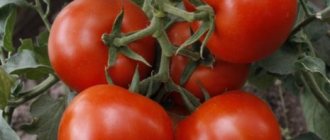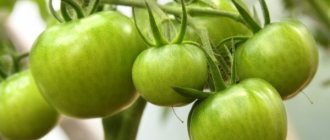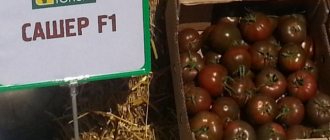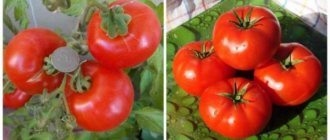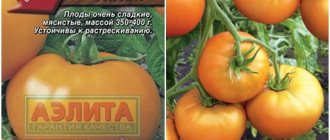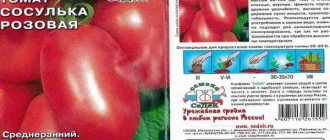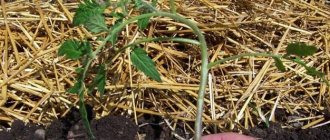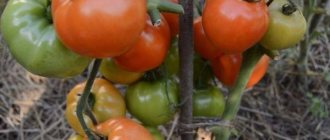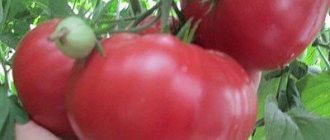Description of the vegetative form
All manufacturers describe the “Sugar Giant” tomato as a tall, indeterminate tomato that requires careful formation and timely pinching.
In the reviews of gardeners there is information that from the seeds that were packaged under the name “Sugar Giant” an indeterminate plant grew with thin shoots, which, however, held powerful fruits quite well.
According to all data, the height of the plant can reach 180 cm.
Ripening tomatoes
In terms of ripening time, everyone describes the variety as mid-season, but reviews say that it should be classified as late. However, some argue that the Sugar Giant tomato variety is early.
Most likely, the matter is not only in misgrading, but also in the growing conditions. To plant tomatoes, you can choose either a greenhouse or a vegetable garden. In greenhouse conditions, naturally, planting occurs earlier and conditions are better, so ripening occurs faster.
How to properly care for vegetables
If vegetables are grown in warm regions, then a bush is formed, leaving two to three stems. With moist, fertile soils, the development of sweet fruits is delayed, so one or two stems are left. Unnecessary stepsons are removed as soon as they are three or five centimeters long.
Characteristics and description of the tomato variety Shchelkovsky earlyRead
Pinching the tops of the shoots will speed up the ripening of the crop, leaving two leaves above the first flower cluster.
Care features include:
- Fertilizing first in the form of a solution of mullein, then with ammonium nitrate (30 grams) diluted in water, superphosphate (40 grams), and potassium salt (15 grams). Continue to apply mineral fertilizers every two to three weeks.
- Water the plant moderately, reducing the amount of moisture before flowering begins.
- The sugar content in the fruits of the variety increases if the leaves that shade the tomatoes are removed in time.
With proper care, the Sugar Giant will produce a large number of sugar fruits and increase their yield.
Diseases and pests
It is impossible to describe the reaction to pathogens and pests of different varieties. However, the fact is obvious that carrying out preventive measures makes it possible to obtain a harvest under any sensitivity of the variety and in any weather conditions.
Experienced vegetable growers fulfill a number of strict requirements when carrying out treatments:
- the first spraying is carried out during the budding period, then every 15-20 days, depending on humidity indicators;
- treatment is carried out with constant alternation of fungicidal preparations, which will not allow microscopic fungi to develop resistance;
- Fungicide solutions are prepared only in accordance with the instructions and before use.
Care Tips
The main measures for caring for tomatoes will be:
- watering;
- fertilizer;
- garter;
- loosening;
- hilling;
- weed removal;
- stepsoning.
After planting and subsequent watering, the next time the plant is moistened after 12 days. Before flowering begins, four liters of water per 1 square meter will be required. m. During the period of releasing flowers and the appearance of the ovary, it is necessary to pour 12 liters per 1 sq. m. m.
There is no need to allow too much waterlogging, as this can lead to the development of fungal diseases. Water for irrigation should only be used warm. And you need to water tomatoes in the evening, after sunset. In this case, you need to try to prevent moisture from getting on the leaves and stems.
We should not forget about spraying - it is better to combine them with foliar feeding and antifungal treatments. The soil should be loosened regularly and combined with hilling
This must be done very carefully so as not to damage the root system.
As we have already noted, tomato bushes grow quite tall, so as soon as they reach a height of 0.5 m, they should be tied to a support.
Since the bushes produce a dense crown, which can prevent the ripening of fruits, it is necessary to periodically thin it out and remove the lower leaves completely. Be sure to get rid of the stepsons growing in the axils of the leaves before they reach 3 cm.
This is done either by hand or with scissors. After the flower stalks appear, you need to make sure that there are not too many of them. At the end of the growing season, pinching of the growing point will be required.
Fertilizing begins after the first ovaries have formed. Complex mineral and organic fertilizers are best suited for them. This tomato takes green fertilizers very well.
Another important maintenance activity is regular weeding and weed removal. It is better to remove weeds by the roots. Fruiting occurs in July-August. The fruits will need to be collected as they ripen.
Among the characteristics of the variety, it is necessary to remember its resistance to diseases and parasites. But still not for everyone. The “Siberian giant” is susceptible to attack by spider mites and whiteflies. The presence of the former is indicated by drying leaves and cobwebs on the bushes.
The fight against mites must begin as early as possible, since this harmful insect drinks the life-giving juices from the plant and thus causes irreparable damage to its productivity.
You should start with repeated treatments with soapy water, bleach, medical alcohol, henbane infusion and effective agricultural methods.
If these methods do not produce results, then move on to a stronger method - the use of an insecticide approved for tomatoes, for example, “Plankt-Pina”, “Aktellika”, “Fitoverma”, “Aktary”, “Fufanon”.
It will be useful for you to read about what types of tomato diseases there are, as well as what methods to combat them.
The presence of small white flying insects in the immediate vicinity and a white coating on the leaves will indicate that the tomatoes have been attacked by a whitefly. In greenhouses, they fight the parasite using sticky tapes and attracting light.
Garlic solution, soap solution, infusion of dandelion, yarrow, solution of copper sulfate, and lime help to get rid of the larvae. Among the chemical preparations used are “Aktellik”, “Aktaru”, “Rovikurt”, “Pegasus” and others.
Among the diseases, “Siberian giant” can be affected by brown spot. To prevent infection with this disease, when growing in greenhouses, it is necessary to comply with humidity and light conditions.
For treatment, use garlic solution, drugs “Barrier”, “Barrier”.
Did you know? Botanists consider the tomato a berry. From the point of view of technological systematics and method of cultivation, it is a vegetable. But in the European Union it is customary to consider it a fruit.
Of course, the “Siberian Giant” variety deserves the attention of gardeners. Its advantages include high yield, ease of care, undemanding soil composition, resistance to diseases and parasites, the possibility of cultivation in cool conditions, excellent quality of large fruits.
There are much fewer disadvantages - among them: too tall bushes that necessarily require support, a narrow scope of use, in particular, the impossibility of preparing juice from them.
Advantages and alternative
If we consider the tomato under the name “Sugar Giant”, then breeders have long been trying for gardeners to create large-fruited varieties and those that have an “excellent” rating when tasting. The market of varieties and hybrids that have passed varietal tests in the regions offers:
- "Sugar Giant";
- "Sugar Bison";
- "Sugar Pud";
- "Giant";
- "Lemon giant"
- "Gigantella";
- "Pink Giant";
- "Red Giant"
By choosing any of these varieties, you will get sweet, tasty, meaty and very large tomatoes.
Varietal advantages and disadvantages
- High yields - up to 33-35 kg of tomatoes per 1 m²;
- Undemanding care - allows even novice gardeners to grow this tomato type;
- High resistance to diseases. Fungal infections in this variety are extremely rare;
- Long fruiting period - allows you to provide your family with a natural product rich in vitamins and nutrients;
- The excellent taste of the fruit delights gourmets;
- You can prepare natural tomato juice and homemade ketchup for the long winter.
Harvest
The disadvantages include the following features of the Sugar Giant:
- The fruits do not tolerate transportation well;
- Tomatoes cannot be stored for a long time;
- The fruits are not suitable for canning.
These shortcomings cannot become an obstacle for gardeners who decide to grow the Sugar Giant variety. These tomatoes will delight gourmets with their excellent taste and the ability to delight guests with vitamin-rich salads and unique sauces.
This is the best tomato for many gardening lovers; the harvest always exceeds any expectations. Gardeners choose this particular tomato for a number of positive characteristics:
- Powerful yield. Up to 5 kg are collected from one bush.
- Various growing methods. They grow and bear fruit well in greenhouses and in open ground.
- Large size tomatoes. By normalizing the ovaries to 2 per cluster, you can get fruits weighing 800 g each.
- Excellent immunity. Resistant to diseases that occur in nightshades.
- Tolerates short frosts and drought well.
- The ability to independently collect seeds for the next crops.
Advice. To obtain large fruits (up to 600-800 g), remove the ovaries, leaving only 2-3 on each cluster.
Cons of tomato:
- a garter is needed, as well as a stepson;
- Feeding will be required: litter, superphosphate or NPK complex (3 times a season);
- stems and branches are weak and can break off under the weight of the harvest.
READ MORE: Aquilegia species description, names of varieties
Growing large-fruited
It is implied that the “Sugar Giant” tomato is large-fruited, since all packers indicate a weight of 500 and above.
In order for a tomato bush to be able to feed not just one large tomato, but to produce a good harvest, it is necessary to take care of the nutritional value of the soil from the seedling period until the moment of harvesting ripe fruits.
Features of the seedling period
If short, determinate tomatoes can be grown in a group method, then tall ones that produce large fruits need individual containers.
Sowing begins in early March, if it is possible to plant seedlings in a greenhouse or open ground in the second half of May.
Sowing
The seeds are initially heated in a humid, warm environment. Sowing is carried out only by those that have produced visible, small roots. They are laid out on compacted nutrient soil at a distance of 2-2.5 cm from each other and sprinkled with 1-2 cm of soil. Watering is carried out through a sieve or from a sprayer. The water should be slightly warmer than the surrounding air.
The crops are covered with glass and set at a temperature of 24-26 ᵒC. After 4-5 days, after the emergence of seedlings, the shelter is removed, and the seedlings are transferred to a bright, but cooler place. The daytime temperature for seedlings is within 16-18 ᵒC, and the night temperature is 14-16 ᵒC.
To prevent the seedlings from stretching out, the place should be very light. After 7-10 days, the temperature is raised by 2-3 ᵒC.
Dive
Tall tomatoes cannot be grown without picking. When the plant has two true leaves, it is removed from the soil and a third of the root is removed by tearing it off. This operation will allow you to transform the root system from a taproot to a more branched form. The larger the area of the root system, the greater the ability of cells to absorb nutrients and grow shoots and fruits.
It is necessary to plant tomatoes in individual containers, the volume of which is in the range of 250-300 ml.
Characteristics and description of the variety
In the name of the variety, the breeders who created it reflected two features at once - the ability to grow in cool regions and bear large fruits. These tomatoes are grown in greenhouses, greenhouses (in the eastern, western regions, the Urals, the Far East), as well as in open ground in areas with a warm climate (central and southern regions). Tomatoes are formed in unusual shapes.
Bush
The bushes of the "Siberian Giant" grow tall - up to two meters in height. Some specimens can reach a height of 2.2 meters. Their stems are dense. The leaves are ordinary in shape and size, no different from other varieties. The highest yields are characterized by bushes that are formed from one or two stems and with a small amount of foliage.
Did you know? The largest tomato in the world was grown thanks to the efforts of US resident Dan McCoy. He weighed 3.8 kg. The record was recorded in 2014. And the largest tomato tree was cultivated by the Japanese. It was the height of a three-story building.
Fruit
The tomatoes of the “Siberian Giant” are large and flat-round in shape. Their skin is pink or bright red. The maximum length of one fruit reaches 10 cm. The average weight ranges from 0.4 to 0.75 kg. Record holders in weight reach 1.2 kg.
As a rule, two or three fruits are formed on one hand. The tomatoes of the “Siberian Giant” are fleshy and sugary. The taste is sweet and very juicy. They release a delicious aroma. In the middle they have five to seven chambers. The fruits contain a small amount of water.
The amount of dry matter is from three to five percent. They are characterized by long shelf life and good transportability.
We advise you to familiarize yourself with the nuances of growing such varieties of tomatoes as “Carrot”, “Pink Spam”, “Bull’s Heart”, “Sugar Pudovichok”, “Cardinal”, “Makhitos”, “Golden Domes”, “Mikado Pink”, “Krasnobay” , “Bokele F1”, “Malachite Box”, “Doll Masha F1”, “Hospitable”, “Monomakh’s Hat”.
Ripening time and yield
This variety is characterized by medium ripeness - appetizing tomatoes appear on the bushes three months after sowing the seeds.
The productivity of the "Siberian Giant" is high. With proper care, it is possible to harvest five to six kilos of tomatoes from one bush per season. From one square meter - up to 12-15 kilograms.
Purpose
“Siberian Giant” tomatoes contain many vitamins and minerals. In cooking they are used for fresh consumption and in salads. They are also suitable for canning. Very tasty when canned in pieces in their own juice. Not suitable for making tomato juice.
Check out recipes for making delicious sun-dried, salted tomatoes, as well as tomatoes in their own juice.
Recently, an interesting way to consume tomatoes is to dry them. This method is good because it allows you to preserve the maximum amount of valuable substances in the vegetable and save it for a long time for preparing dishes in the winter.
Did you know? For a long time, Americans and Europeans considered the fruits of the tomato tree to be inedible and even poisonous. In Europe, they were cultivated only for decorative purposes; they decorated gardens and greenhouses. The American Robert Gibbon Johnson managed to refute this misconception in 1820, when he publicly ate a bucket of tomatoes.
